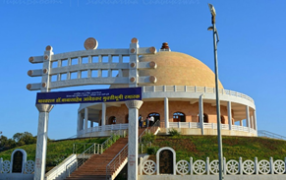
Beloved Children,
Om Namo Sainathaya
A Group of young children who had come to Shirdi requested the SAI AURA team to take them to Yeola to visit Anandanath Maharaj and his Ahram – 60 km away from Shirdi, on the Kopergaon – Manmad Rail route. 5 km from Yeola village. We hired a van and it was a blissful trip.

On reaching the Ashram we were received by a German monk Swami Sai Ananda who took care of our needs and showed us the Ahram.
Anandanath Maharaj was 95 years old in 1854 when Sai Maharaj came to Shirdi they used to meet quite often and there is a reference to the Maharaj in Chapter 5 of Sai Satcharita.
Anandanath Maharaj resembled Swami Samarth, who is known as Akkalkot Maharaj and we were told that Swami Samarth visited Yeola Ashram and created a well and a lake with crystal clear water. Swami Samarth also materialized an idol of Dutta which is worshipped at Anandanath Maharaj’s sanctum.
The children asked Swami Sai Anand a few questions about a few mythological pictures there. Swami replied that the core idea of mythological animals is to bring together lofty goals to embellish our lives and guide us toward excellence.
He said – ‘The desire to excel in every aspect of human life is as old as life itself. All our ancient texts ‘Lead me from darkness to light, from falsehood to truth, and from the fear of death to the knowledge of immortality’, from the Brihadaranyak Upanishad, or the even older lines yearning to be of one mind without discord, as mentioned in the Rig Veda, the aspiration has always been lofty. Anandanath Maharaj in turn has held up to be an example to illustrate it.
Rama was described by Valmiki as being as forgiving as the earth and as dignified as the mountains. Birds and animals also became ideals for human aspirations. An endearing example  is that of the parrot, the image of which is woven into the bridal saris by the mother of the bride. The parrot is said to visit only beautiful spots where there are plenty of fruits; so the mother wishes her daughter lives in a house of abundance and beauty. The hans is another common motif ornamenting saris and even temple doorways. It is believed to have the ability to separate milk from water, symbolizing that it is endowed with the wisdom of discernment and represents the pure soul which is full of wisdom.
is that of the parrot, the image of which is woven into the bridal saris by the mother of the bride. The parrot is said to visit only beautiful spots where there are plenty of fruits; so the mother wishes her daughter lives in a house of abundance and beauty. The hans is another common motif ornamenting saris and even temple doorways. It is believed to have the ability to separate milk from water, symbolizing that it is endowed with the wisdom of discernment and represents the pure soul which is full of wisdom.
Swami Sai Ananda continued – ‘The elephant was highly revered for its majestic appearance, its incredible memory, its usefulness in battle, and the fact that it does not kill to feed itself. Human genius added wings to this creature so that an element of the divine was introduced. The flying elephant is a mythological creation of many cultures. So too the horse. The flying horse, known variously in different cultures as Uchchaishravas, Pegasus, or Devadatta holds the same idea. By adding wings, the speed and power of the horse gained sacred connections
Then came animals which were a combination, like the shardula. There is a school of thought that perhaps animals like the shardula did exist. The shardula has been translated as the lion or the tiger, but iconographically it seems to be a combination of the lion and another animal or bird, which could be a horse or an elephant and so on. Sita mentions it in Valmiki Ramayana as one of the frightening beings that roamed the forest. In common parlance, the shardula has come to symbolize the resplendent, the most powerful, and the best.
The makara is another fascinating animal, as far as our knowledge goes, mythical. It comes with the body of a fish, the trunk of an elephant, the feet of a lion, the eyes of a monkey, the ears of a pig, and the tail of a peacock. An aquatic animal, it is considered auspicious as it has beauty and prowess of every kind. Therefore, it ornaments many temples.
The Navagunjara comes with a story. It is said that Arjuna was meditating when a creature appeared before him. It had the face of a rooster. It had one foot raised like a human arm holding a lotus in its hand. The other three feet belong to an elephant, a tiger, and a horse. Furthermore, it had the neck of a peacock, the hump of a bull, the waist of a lion, and its tail was a serpent. Arjuna prepared to attack it but realized it was the Vishwaroop, the unified divine form of Krishna.
The ‘Satsang’ at the Ashram of Anandanath Maharaj was blissful and we returned with happy memories.
Sai Aura Team

Leave a Reply